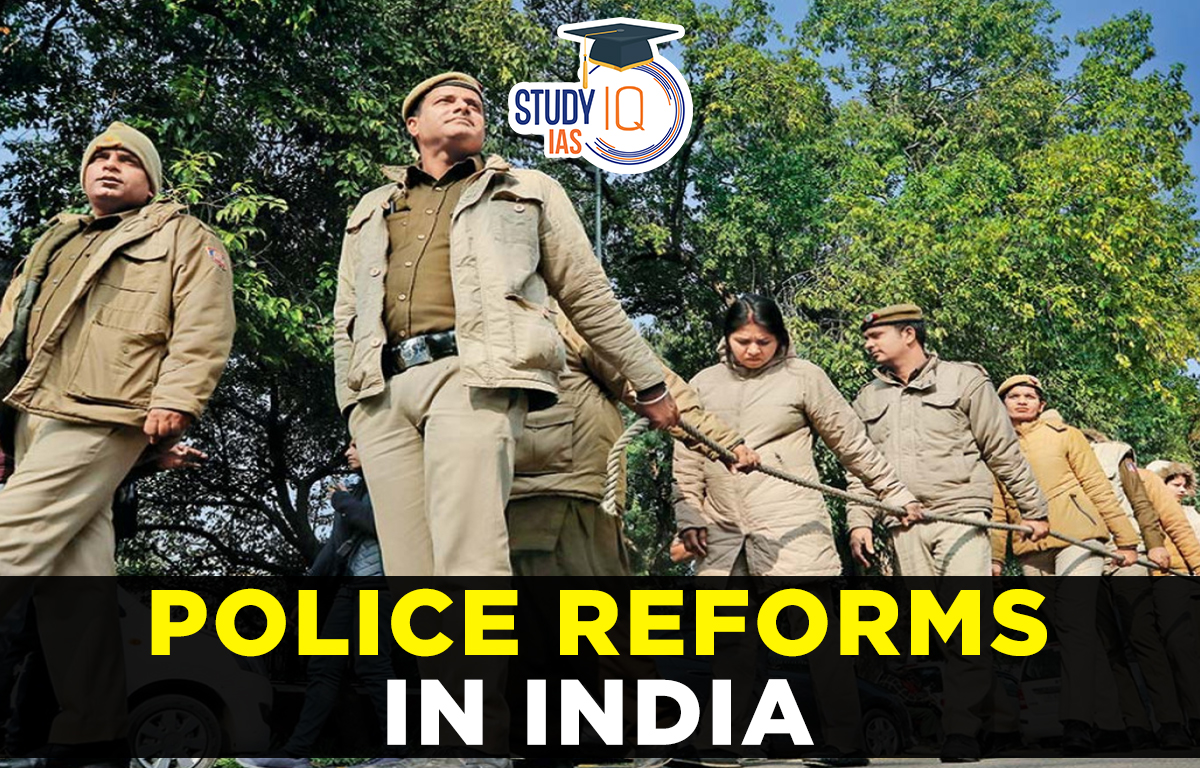Table of Contents
Context: The ‘India Justice Report 2022’ notes that the gap between the sanctioned and actual strength in police forces, at the national level, remains “worryingly large”.
What is the ‘India Justice Report 2022’?
- It is an initiative of Tata Trusts in collaboration with Centre for Social Justice, Common Cause and Commonwealth Human Rights Initiative among others.
- It was first published in 2019. It assesses the performance of states in terms of justice delivery, by considering several parameters such as police, judiciary, prisons, and legal aid to assess the overall performance of each state.
- The report collates data from various official sources for 25 ranked States, dividing them into two clusters — 18 large and mid-sized States and seven small-sized States (populations up to 10 million).
What are the Major Findings of the Report Related to Police Forces in India?
- Vacancies in Police Forces: Overall vacancies in police rose from 20.3% of the sanctioned strength to 22.1% between January 2020 and January 2022.
- Vacancies in constabulary: As of January 2022, Kerala was at the top with constable vacancies making up 4.6% of the sanctioned strength, while West Bengal was the worst performer with vacancies amounting to 44.1% of the sanctioned strength.
- Officer vacancies: As for police officers (in civil as well as District Armed Reserve police), Bihar has the highest percentage of vacancies at 53.8% as against the sanctioned strength.
- Fulfillment of reservation quotas: Despite years of reservations, Karnataka was found to be the only State to meet its SC, ST, and Other backward classes quotas, with no other State/UT managing to meet all three of their reservation targets.
- Women’s representation in the police force: The report noted that, on a national level, it will take another 24 years to have 33% women in police forces across States.
- State-wise performance: Andhra Pradesh, which reserves 33% of overall police posts for women, performed the best with 21.8%, while Jharkhand was the worst performer with just 6.2%.
Police and Policing Framework in India
- The primary role of police forces is to uphold and enforce laws, investigate crimes and ensure security for people in the country.
- In a large and populous country like India, police forces need to be well-equipped, in terms of personnel, weaponry, forensic, communication and transport support, to perform their role well.
- Constitutional and legal provisions:
- Under the Constitution, ‘Police’ and ‘Public Order’ are state subjects under the Seventh Schedule to the Constitution of India. Therefore, each state has its own police force.
- The centre is also allowed to maintain its own police forces to assist the states with ensuring law and order.
- The basic framework for policing in India was laid down in the pre-independence era through the Police Act, 1861.
- Apart from the above, several other laws and regulations govern police functioning in India. These include the Criminal Procedure Code (CrPC), Indian Penal Code (IPC), Evidence Act and various state-specific laws.
What are the Various Issues Faced by the Police Forces in India?
- The following expert bodies have examined issues with police organisation and functioning over the last few decades. They have identified the major issues, which include:
| Police Accountability | Accountability to the political executive vs operational freedom: Both the central and state police forces come under the control and superintendence of the political executive (i.e., central or state government).
The Second Administrative Reforms Commission (2007) has noted that this control has been abused in the past by the political executive to unduly influence police personnel and have them serve personal or political interests. |
| Human Resources Issues | Overburdened police force: United Nations recommended standard is 222 police per lakh persons, while actual police strength in India is at around 137 police per lakh persons.
It leads to increased work stress on police personnel, that compromises the overall performance of police in the discharge of their duties. Absence of incentives to perform: 86% of the state police comprises of constabulary and lack of promotion prospects weaken their incentive to perform. Gender inequality: Women are underrepresented in the police force, constituting only 10.3% of police force. |
| Infrastructural Issues | Physical infrastructure: Infrastructure is mostly lacking at the level of police stations.
According to Bureau of Police Research and Development (BPRD) data (2020), several police stations have been found with no wireless, no telephone and no vehicles. CAG audits and BPRD has found shortages in weaponry and lack of modern weaponry with state police forces. Technology: Indian Police forces have not kept pace with changes in technologies like forensics, fingerprinting, facial recognition etc. For example, Crime and Criminal Tracking Network & Systems (CCTNS) is facing implementation issues like limited usage etc. |
| Funding Issues | Insufficient financial allocation: Expenditure on police accounts for about 3% state government budgets.
Underutilization of funds for modernization: Funds dedicated for infrastructure modernization are typically not utilized fully. According to the latest data, states/UTs managed to utilize less than 40% of the funds. |
| Police-Public Relations | Police requires the confidence, cooperation and support of the community to prevent crime and disorder.
The Second Administrative Reforms Commission has noted that police-public relations are in an unsatisfactory state because people view the police as corrupt, inefficient, politically partisan and unresponsive. |
Government Initiatives
- Crime and Criminal Tracking Network System (CCTNS): It is conceptualized by the Ministry of Home affairs, to create a comprehensive and integrated system for enhancing the efficiencies and effective policing at all levels and especially at the Police Station level.
- Modernisation of Police Forces (MPF) scheme: It a centrally sponsored scheme, was initiated in 1969-70. Its objective is to reduce dependence of State Governments on Army and Central Armed Police Forces to control internal security and law and order situations by adequately equipping State Police Forces and strengthening their training infrastructure.
- The Centre has approved the continuation of Modernization of Police Forces (MPF) scheme for five years up to 2025-26.
- SMART policing: To encourage innovations and the use of modern technologies, SMART Policing has been introduced. It implies S-Sensitive and Strict; M-Modern and Mobility; o A-Alert and Accountable; R-Reliable and Responsive, and T- Trained and Techno-savvy.
- Model Police Act, 2006: It replaced the Police Act, 1861. The Act provided for social responsibilities of the police and emphasized that the police would be governed by the principles of impartiality and human rights norms, with special attention to the protection of weaker sections including minorities.


 TNPSC Group 4 Admit Card 2025 Out at tnp...
TNPSC Group 4 Admit Card 2025 Out at tnp...
 Species Added to India's Flora and Fauna...
Species Added to India's Flora and Fauna...
 Daily Quiz 02 July 2025
Daily Quiz 02 July 2025





















